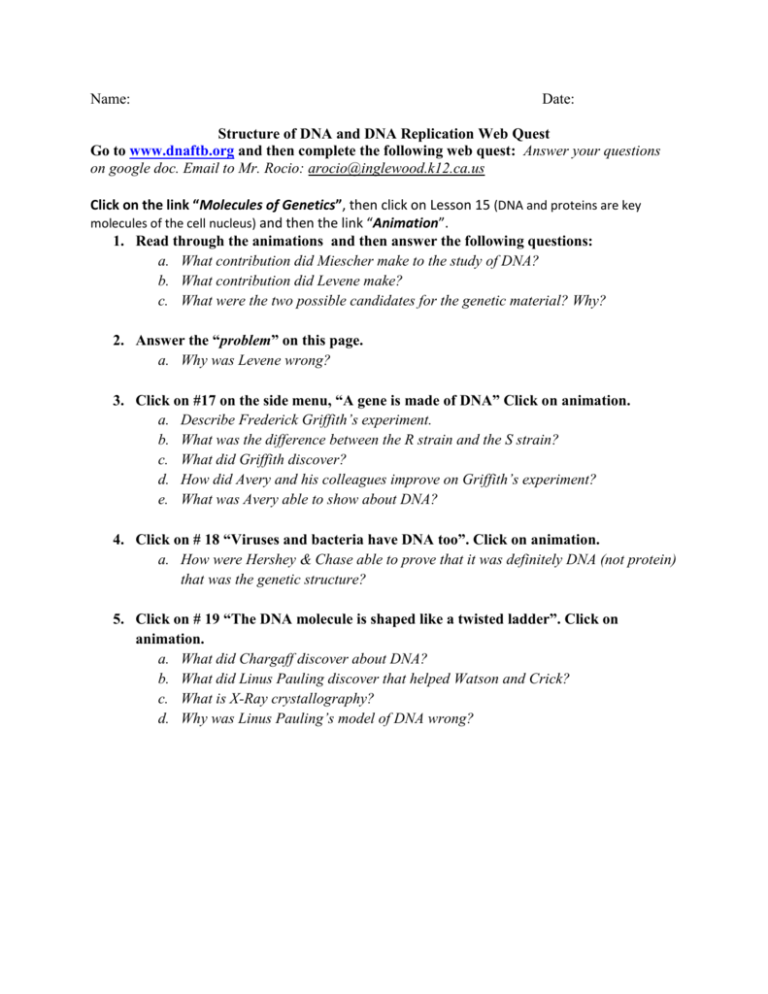DNA Webquest
advertisement

Name: Date: Structure of DNA and DNA Replication Web Quest Go to www.dnaftb.org and then complete the following web quest: Answer your questions on google doc. Email to Mr. Rocio: arocio@inglewood.k12.ca.us Click on the link “Molecules of Genetics”, then click on Lesson 15 (DNA and proteins are key molecules of the cell nucleus) and then the link “Animation”. 1. Read through the animations and then answer the following questions: a. What contribution did Miescher make to the study of DNA? b. What contribution did Levene make? c. What were the two possible candidates for the genetic material? Why? 2. Answer the “problem” on this page. a. Why was Levene wrong? 3. Click on #17 on the side menu, “A gene is made of DNA” Click on animation. a. Describe Frederick Griffith’s experiment. b. What was the difference between the R strain and the S strain? c. What did Griffith discover? d. How did Avery and his colleagues improve on Griffith’s experiment? e. What was Avery able to show about DNA? 4. Click on # 18 “Viruses and bacteria have DNA too”. Click on animation. a. How were Hershey & Chase able to prove that it was definitely DNA (not protein) that was the genetic structure? 5. Click on # 19 “The DNA molecule is shaped like a twisted ladder”. Click on animation. a. What did Chargaff discover about DNA? b. What did Linus Pauling discover that helped Watson and Crick? c. What is X-Ray crystallography? d. Why was Linus Pauling’s model of DNA wrong? Use the websites provided to answer the questions below about the structure and function of nucleic acids in our cells. DNA: The Double Helix (from Nobel Prize): http://www.nobelprize.org/educational/medicine/dna_double_helix/dnahelix.html 6. What is the full name of DNA? 7. What is the shape of DNA? 8. What are the “rungs” of the ladder? 9. Which nitrogenous bases pair together? 10. Play the game for all three organisms. Record your answers after completing each organism in the chart below. Chromosome # How many chromosomes? How many base pairs? How many genes? What is the organism? 1 2 3 DNA Replication Simulation: http://www.johnkyrk.com/DNAreplication.html 11. DNA must be replicated prior to _______________________________. 12. Errors during DNA replication are called _____________________________. 13. Describe a hydrogen bond. How many hydrogen bonds form between A and T? G and C? 14. Does DNA replication start at only one place in the DNA or in many places at once? 15. In the chart below, describe what each enzyme does during the replication process. Name of Enzyme: Helicase Function during DNA replication: RNA primase DNA polymerase Exonuclease Ligase 16. The two types of cell division are _______________ and ________________. Genetics Tour: http://learn.genetics.utah.edu/content/begin/tour/ 17. The DNA strand is made of letters, the letters make words, and the words make sentences. These sentences are called ______________________. 18. What is a gene? 19. Approximately how many genes are encoded in the DNA of humans? 20. ____________________________ is a genetic disease that results in the mutation of hemoglobin protein within our red blood cells. 21. Other than providing instructions for building a hemoglobin molecule, what are two other examples of traits that are controlled by genes? 22. Look at the set of human chromosomes displayed on the slideshow. Is this set of chromosomes from a male or female? How do you know? 23. Humans have 46 chromosomes. Mosquitoes have _____. Onions have _____. Carp have _____. 24. If our body is compared to a car engine, why can proteins be compared to the parts of the engine? 25. ________________________ proteins allow a cell to keep its shape. 26. Where within the cell are proteins made? 27. The passing of ______________________________________ is the basis of heredity. 28. Other than genes, what is the other major factor that helps define our traits? 29. What is a zygote? 30. When looking at the “First Baby’s Possible Chromosomes” and the “Second Baby’s Possible Chromosomes” from their parents, determine if the babies are identical or fraternal twins. How do you know? 31. What is a trait? 32. What is the difference between a physical trait and a behavioral trait? 33. What are some diseases that can be passed down as genetic traits? List 5 or more. 34. When thinking about the risk of developing heart disease, what can be influenced by genetics? What is influenced by behavior? 35. Will people that have the genotype “Hh” have two straight thumbs, two hitchhiker’s thumbs or one of each? 36. The flower’s petals are influenced by a principle called __________________________. 37. All humans share _________% identical DNA.







